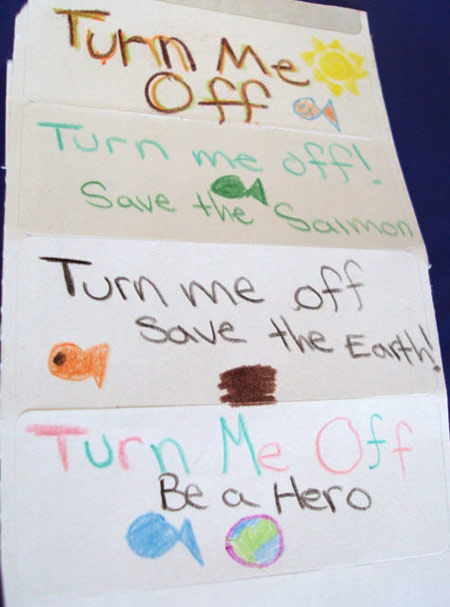Success story: Eastgate Elementary School
School District: Bellevue
School Location: Bellevue
Began participating in the Green Schools Program: September 2009
Level One of the Green Schools Program: Achieved in May 2010
Level Two of the Green Schools Program: Achieved in April 2011
Level Three of the Green Schools Program: Achieved in April 2012
Green team efforts
- The student Green Team completed the following activities.
- Checked classrooms for waste reduction and recycling practices.
- Placed stickers that list what can and can’t be recycled on all recycling containers.
- Created artwork out of recycled materials.
- Made a presentation to staff about waste reduction and recycling.
Waste reduction and recycling (level one)
- To reduce paper use, staff makes double sided copies and uses e-mail communication and smart boards.

- Using empty photocopy paper boxes, paper reuse stations were set up in classrooms to encourage students to use both sides of each piece of paper.
- Some teachers sent grades via e-mail.
- A book swap is held at the end of each school year.
- An inventory of school recycling containers was completed and recycling containers were added to classrooms, offices and the school’s cafeteria where needed.
- While continuing to recycle milk cartons, the school began to recycle food scraps and other compostable materials in the cafeteria.
- The City of Bellevue partnered with the Green Schools Program to assist Bellevue schools with recycling improvements.
- In 2010-11, the school increased its recycling rate from 50 percent to 68 percent.
- The school reduced garbage volume from 8 yards per week to 6 yards per week.
- The student green team created garbage and recycling posters for curriculum night.
- The student green team also created a “goldfish crackers” display to show how parents can save money and help the environment by buying in bulk and using durable containers to pack school lunches and snacks rather than buying individual packets.
- Three second grade classes participated in the “healthy habitat” workshop.
Energy conservation (level two)
- Outdoor lights were placed on timers.
- The basketball court lights were turned off when not in use.
- From September through December 2010, Eastgate Elementary was able to reduce energy use by almost 16 percent due to energy conservation practices and reduced heating temperature requirements from the District.
- Student green team members made “lights out” stickers and a salmon display to show how turning off lights can help save salmon.
- Students invited a City of Bellevue representative to their team meeting to learn about energy conservation.
- Students placed energy conservation labels near all light switches in the school.
- The student green team created an energy conservation patrol to check classrooms to make sure lights and computers are off when not in use.
- During monthly staff meetings, ideas were discussed to conserve resources and energy use, including ways to use less paper and to use more electric forms instead of hard copies.
- Students made posters about energy conservation and posted them throughout the school.
- The green team worked with the tech coach to find out which projectors were turned off when not in use, and held a raffle for teachers that turned off their projectors when they were not needed.
- The green team made announcements and included an article in a parent newsletter about energy conservation.
Water conservation and pollution prevention (level three)
- Three 4th grade classes participated in Nature Vision’s “healthy water systems” workshop.
- The student green team used the water conservation resource tub materials from the City of Bellevue.
- The student green team measured the flow of water from faucets in their classrooms and in student restrooms to find out how much water flowed during a 5 second period.
- Student green team members posted reminders about conserving water in all restrooms.
- Student green team members created stained-glass designs with suggestions for conserving water which were posted in windows around the school.
- Tips for conserving water were included in morning announcements by the principal.
- Three 4th grade classes visited the Cedar River Watershed and studied the water cycle from the watershed to our drinking water and then eventually out to Puget Sound.
- Three 5th grade classes spent a full day on a boat in Puget Sound conducting hands-on experiments under the guidance of professional scientists to measure water quality in Puget Sound and the amount of pollutants and aquatic life. The goal of the experience was to develop a sense of life-long stewardship for Puget Sound.
- Fresh drinking water and recyclable cups were introduced into the cafeteria during lunch periods to reduce the amount of bottled water and other single-use beverage containers that students brought from home for their lunches.
- In the staff room teachers pledged to stop purchasing and bringing bottled water to school, and to use tap water and washable glasses/cups in the staff room.
- As a new school which opened three years ago, the building was designed with water conservation in mind. Drought tolerant landscaping was planted, and building materials were purposely selected with water and other resource conservation in mind.
For more information about the school’s conservation achievements and participation in the Green Schools Program, contact:
Eastgate Elementary School
425-456-5100


 Translate
Translate
